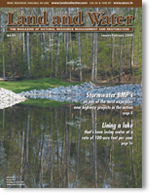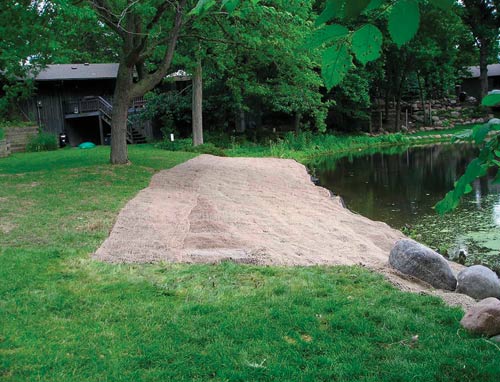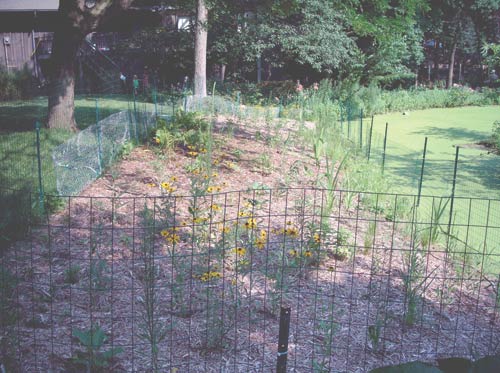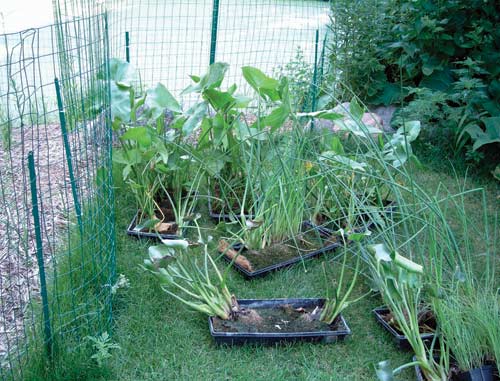The Pond Edge:Manicured Lawn vs. Functioning Ecosystemby Carolyn Dindorf, Laura Jester and Jenn Morrow |
People are attracted to water. When the opportunity to own a home on a pond or lake arises, many jump at the chance. As lake property in urbanized areas is scarce, small natural ponds and stormwater treatment ponds are the new “lakeshore”. Unfortunately, it is common to see the shoreline of these ponds managed as a manicured lawn or a ribbon of rock (riprap) at the water’s edge. We have the opportunity to make these ponds function more like natural systems by helping homeowners appreciate ponds as ecosystems with native shoreline vegetation. Here’s one landowners story: Discovering the edge While one third of the pond edge was left as wooded backyards, when the snow melted away, we were dismayed to realize that three large lawns bordered the pond, meticulously manicured right to the edge; ours included! We knew we would not mow nearly as much lawn as the previous owner, but what we didn’t know was that our new buffer would be fertile ground for an enormous amount of noxious weeds. Not mowing simply wasn’t enough. After three summers of pulling thistles, I had enough! It was time to start from scratch and go native. I wanted a wild look that would add aesthetics, habitat, slow down runoff, and hopefully, set an example among our neighbors of how best to treat our pond. I enlisted the help of Fortin Consulting, Inc. to help with site preparation and the planting plan and Hild and Associates to provide the plant materials. Control without chemicals Going Native The rest of the summer we nurtured the area (with frequent watering and a fence to protect from geese) and watched our pond edge come to life! Many of the wildflowers bloomed that season and our neighbors commented on the wonderful transformation. Almost a year later, we continue to enjoy our shoreline and look forward to watching it evolve, grow, and provide many wildlife and water quality benefits.
Designing the Perfect Pond Edge Keep a few things in mind when creating a plant list. First, native plants are preferred due to their adaptation to local climate. They have persisted as long as they have by surviving the variations in temperature and moisture that exist in their home region. Also keep in mind aesthetics. Within the group of plants that are native to a region, and suitable for a site, there are some that fit the aesthetic goals of any planting. Some criteria to keep in mind are mature height, flowering color & time, and aggressiveness of any particular species. Remember that flowers (forbs) and grassy (graminoides) species grow together in nature and form a community. Be sure to include both flowers and grasses in any plant list. There are many landscape designers that are familiar with native species and can create very specific designs with them, even using native species in traditional manicured designs. Wildlife habitat enhancement or wildlife exclusion may be goals that a pond’s edge planting wants to achieve. Both can be considered when choosing the correct plants. For example Canadian geese are fond of traditional mown lawns and emerge from the pond to graze and befoul many a lawn. Geese are hesitant to pass through tall grass where predators may be concealed. There are many resources that include the habitat and forage benefits of many native plants. Another option for creating aquatic habitat is floating islands. They have been a unique part of aquatic systems that have not been successfully re-recreated until recently. Pay attention to the hydrology of the pond for at least one season before deciding on a species list. Does the water drop dramatically July through August? Does it ‘bounce’ with every storm event? Many of the ponds in back yards these days are connected to the municipal stormwater system and experience fluctuations due to rain events. Take these into account when choosing where to plant aquatic species and transitional species. Once a plant list has been established, there are several options for planting. Although people often shun them, submergent or floating-leaved species such as water lilies and coontail are important parts of a healthy aquatic environment. They provide habitat and water quality benefits and are an important part of a well balanced water body. Beyond the submergents, there are several options for planting a pond’s edge. Aquatic & transitional species seed is available however it is not recommended. Emergent species, those that grow in several inches to several feet of water such as bulrushes, are difficult to grow from seed in the wild. Plugs and bare root material are available and preferred. Emergent species tend to be buoyant; planting requires a way to hold them in the substrate until the roots have the opportunity to establish. Wind & wave action and wildlife can dislodge plugs so care should be taken to protect a planting. Wave breaks and goose fence are two options. Dowels or stakes of other sorts can be pushed through the root ball or rocks can be tied to bare root material to hold it down. Emergent species can also be grown in a coconut mat that can be staked down or held down with a few rocks to improve their establishment. For severely eroded shorelines or changes in grade, a prevegetated coconut fiber ‘log’ can be used to fortify the shore while allowing native plants to establish and take over the task. Prevegetated coconut products are specially grown by some native nurseries and bioengineering companies. Transitional species such as sedges and wet tolerant forbs are available in plugs that are usually one, two or four inches square. The transitional zone should be mulched to discourage weeds and retain moisture during establishment. A coconut fiber erosion control blanket is also a good option for the shoreline, especially if fluctuations in water level are expected and mulch may be washed away. The upland portion of the planting area can either be seeded or plugged. If seed is used to establish this portion of the planting an erosion control blanket should be used to protect the seed and keep the site from eroding into the pond. Most small ponds and especially stormwater ponds do not have clear water. In fact, they are often turbid, weed choked or green with algae or duck weed. Cities are sometimes plagued with complaints from unsuspecting new homeowners that purchased property on a pond that may have looked nice in the early spring, fall or winter. Many of these ponds, especially those created for treating stormwater, will never meet the expectations of homeowners.
A new perspective on ponds Aquatic plants provide homes and food sources for invertebrate species such as dragonflies that spend most of their life in the water. Native plants allow us to create this sanctuary. Native wildflowers, grasses and shrubs surrounding the pond not only enhance aesthetics by adding a variety of colors and textures, but also keep our eyes distracted from the algal blooms and weed growth that is likely to occur in small ponds. Although they won’t cure a green pond, these native plantings can reduce pollutant loading from a yard. Native plants don’t require fertilizer like a manicured lawn. Since a native planting doesn’t require regular mowing, grass clippings aren’t likely to end up in the pond. In fact, native plants, with their fibrous and deep root systems, will increase infiltration and thus reduce runoff into the pond. They will also help filter pollutants that may be carried in stormwater from the area above the planting. Hopefully more and more homeowners can come to see the beauty and the benefits of a natural pond edge. As urban areas grow, and shorelines give way to backyards, our ecosystems depend on it! For more information, contact Carolyn Dindorf, Limnologist at Fortin Consulting, Inc, 763-478-3606, email:carolyn@fortinconsulting.com, web site: www.fortinconsulting.com or Laura Jester, Watershed Conservationist with the Dakota County Soil and Water Conservation District and the pond property owner at (651) 480-7784, email: laura.jester@co.dakota.mn.us or Jenn Morrow Hild & Associates, Inc., 715-426-5131, email:jmorrow@hildandassociates.com, |
©2006 - 1998 Land and Water, Inc.





